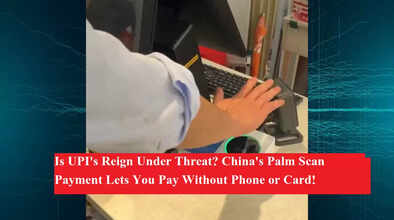Is UPI's Reign Under Threat? China's Palm Scan Payment Lets You Pay Without Phone or Card!

Imagine making a payment without pulling out your phone, wallet, or card. Sounds futuristic, right? Well, it’s already happening in China. A new payment technology launched by WeChat (Weixin) allows users to scan their palm to make payments — no physical contact, no devices. The technology has gone viral on social media, sparking global curiosity and even debate about whether this could outpace India’s UPI system.
Let’s dive into what this tech is, how it works, and whether UPI should really be worried.
Indians : Cash is the king
— Coach Rajan (@sibalsahab) April 13, 2025
Meanwhile in china : pic.twitter.com/1jgpUnKzSO
✋ Palm Scan Technology: A New Era of Payments
Introduced in May 2023, this palm recognition service by WeChat was first deployed at Beijing's Airport Express Train Line and Shenzhen University. Within just a few months, it expanded to over 1,500+ 7-Eleven stores across China.
Now, this futuristic tech is being used in various sectors including:
-
Retail stores
-
Transport hubs
-
Power bank rental stations
-
Gyms and educational institutions
All you have to do is wave your palm in front of a scanner, and after a one-time registration on the app, the system identifies your palm’s unique vein pattern and authorizes the payment instantly.
📱 No Phone, No Card – Just Your Hand
A now-viral video shows a man walking into a 7-Eleven store in China, buying a drink, and simply scanning his palm to pay – without touching his wallet, phone, or card.
He says in the video:
"This is linked to my WeChat ID. I paid without my phone or wallet – this is insane!"
The video sparked mixed reactions on social media, especially among Indian users, with comments ranging from admiration to comparison with India’s digital payment landscape.
🇮🇳 UPI vs Palm Scan: Internet Divided
While some users hailed China's palm scan as “next-level innovation,” others defended India's powerful and inclusive UPI system.
One user tweeted:
👉 “If I had seen this video on April 1st, I’d have thought it’s an April Fool’s joke. China is 50 years ahead while we’re still debating another statue.”
Another user responded:
👉 “Don’t belittle India. Here we buy ₹10 coriander using Paytm. India leads in digital payments and quick delivery too.”
The conversation reflects a strong national pride in India’s UPI-driven digital economy, but there’s also growing curiosity about how far biometric payments can go.
🔍 How Does Palm Scan Stack Up Against UPI?
| Feature | Palm Scan (China) | UPI (India) |
|---|---|---|
| Device Requirement | Just a Palm Scanner | Smartphone and Internet |
| Payment Method | Biometric Palm Scan | App-based QR/Numeric Transfer |
| Security Level | High (Palm Vein Mapping) | Moderate to High (PIN, Fingerprint) |
| Accessibility | Limited to select locations | Widely accepted across India |
Palm scan payments may feel like science fiction, but it’s very much real and expanding. UPI, on the other hand, has already revolutionized small and large-scale transactions, even in the remotest parts of India.
💡 Will India Adopt Palm Scan Technology?
Technically, yes — India can implement this system. But several factors need to align first:
-
Availability of palm scanners across the country
-
Strong data privacy and biometric protection laws
-
Public trust and willingness to adopt such futuristic tech
While India’s digital revolution is powered by smartphones and internet access, palm scan would require a shift towards biometric-based identification systems.
📌 Conclusion: Is UPI in Danger? Not Yet.
As of now, UPI remains the most robust, accessible, and widely accepted digital payment system in the world. However, China’s palm scan innovation signals what the future may look like — contactless, cardless, and seamless.
India may not need to worry immediately, but keeping an eye on such technologies is essential. As tech evolves, so will the way we transact.

